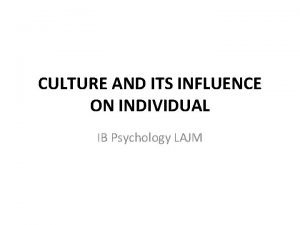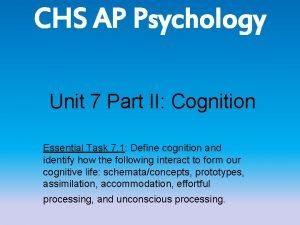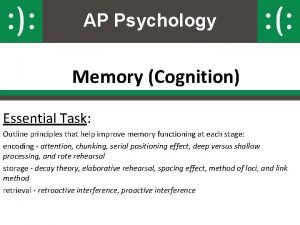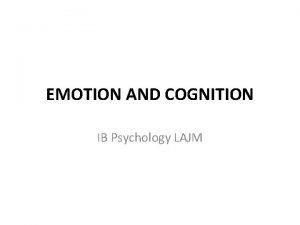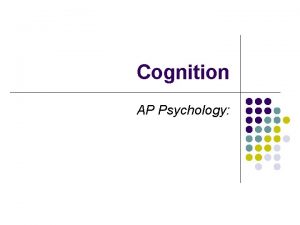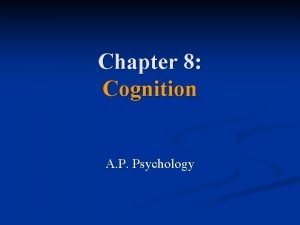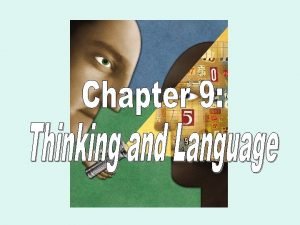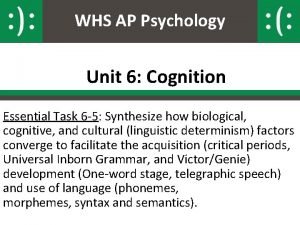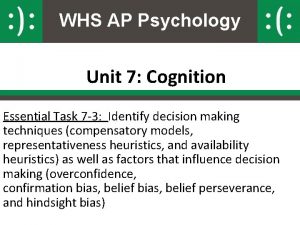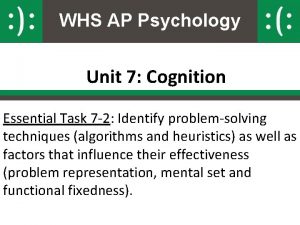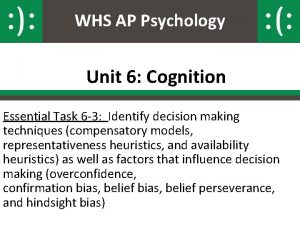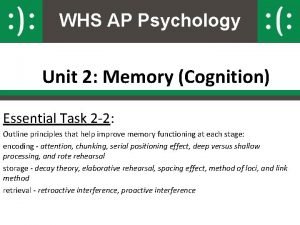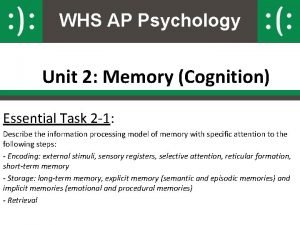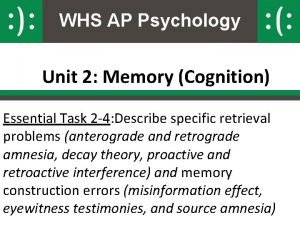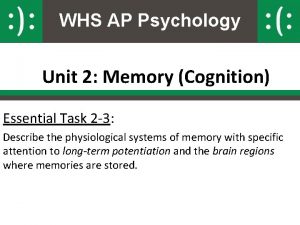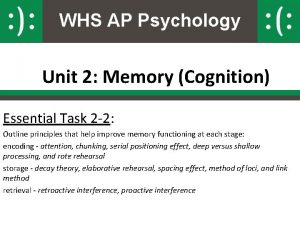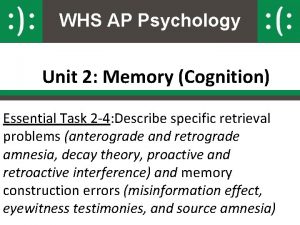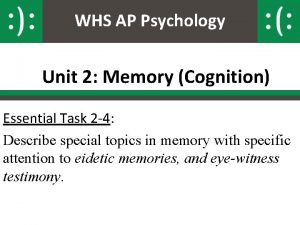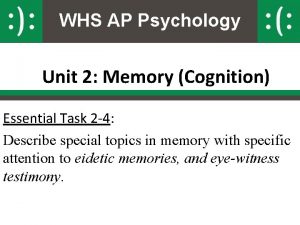WHS AP Psychology Unit 6 Cognition Essential Task

















- Slides: 17

WHS AP Psychology Unit 6: Cognition Essential Task 6 -2: Identify problem-solving techniques (algorithms and heuristics) as well as factors that influence their effectiveness (problem representation, mental set and functional fixedness).

Algorithms Problem Solving Techniques Representativeness Heuristic Compensatory Models Heuristics We are here Decision Making Techniques Availability Heuristic Unit 6: Cognition Obstacles to Problem Solving Obstacles to Decision Making Biological Factors Acquisition and use of Language Cognitive Factors Information Processing Model Memory Cultural Factors Encoding Storage Retrieval

Essential Task 6 -2: Outline • Problem Solving Steps • Identify problem-solving techniques: – algorithms – Heuristics • • Hill climbing Sub-Goals Working backwards Means end analysis • Factors that influence their effectiveness – – problem representation mental set functional fixedness motivation

4 Problem Solving Steps 1. Define the Problem 2. Use that definition to decide what category a problem belongs to and then based on that 3. Select a solution strategy that would solve a problem in that category 4. Always evaluate progress toward goal

Possible Solution Strategies • Trial and error – Works best with limited number of choices • Information retrieval – Retrieve from memory information about how such a problem has been solved in the past • Algorithms – Step-by-step methods that guarantees a solution – Methodical, logical rules or procedures that guarantee solving a particular problem. – Math problems are an example of the type best solved using an algorithm • Heuristics – Rules of thumb that may help simplify a problem, but do not guarantee a solution. – They are quicker than algorithms

Algorithms, which are very time consuming, exhaust all possibilities before arriving at a solution. Computers use algorithms. SPLOYOCHYG If we were to unscramble these letters to form a word using an algorithmic approach, we would face 907, 208 possibilities.

Heuristics • In psychology, heuristics are simple, efficient rules, learned from experience, that people use to make decisions, come to judgments, and solve problems typically when facing complex problems or incomplete information.

Heuristics make it easier for us to use simple principles to arrive at solutions to problems. SPLOYOCHYG P S PS P S LY O CY HO OCL H OG GY Y Heuristic at work: Y’s usually go at the end of a word.

Heuristic Methods • Hill climbing – Move progressively closer to goal without moving backward • Sub-goals – Break large problem into smaller, more manageable ones, each of which is easier to solve than the whole problem • Means-end analysis – Aims to reduce the discrepancy between the current situation and the desired goal – subgoals not immediately in the solution direction are considered • Working backward – Work backward from the desired goal to the existing condition

Hill Climbing Heuristic • Move progressively closer to goal without moving backward

Sub-goals • Break large problem into smaller, more manageable ones, each of which is easier to solve than the whole problem

Means-end analysis • Aims to reduce the discrepancy between the current situation and the desired goal – subgoals not immediately in the solution direction are considered

Working backward • Work backward from the desired goal to the existing condition

Obstacles to Solving Problems • Motivation – Desire to solve a problem • Mental sets – Tendency to perceive and approach problems in certain ways • Functional fixedness – Tendency to see only a limited number of uses for an object

Motivation • If you don’t attempt to solve a problem you won’t.

Mental Set • “We can't solve problems by using the same kind of thinking we used when we created them. ” Albert Einstein

Functional Fixedness • “I can only use it for this one thing!”
 Ap psychology unit 7 cognition
Ap psychology unit 7 cognition Acculturation studies ib psychology
Acculturation studies ib psychology Cognition definition ap psychology
Cognition definition ap psychology Chunking ap psychology examples
Chunking ap psychology examples Teacup ib psychology
Teacup ib psychology Unlike b.f. skinner, noam chomsky believes that children
Unlike b.f. skinner, noam chomsky believes that children Representative heuristic
Representative heuristic Embodied cognition ap psychology
Embodied cognition ap psychology Wwusd whs
Wwusd whs Confidence interval assumptions
Confidence interval assumptions Model whs act
Model whs act Swms meaning
Swms meaning Study whs
Study whs Essential non essential fatty acids
Essential non essential fatty acids Mission essential task list
Mission essential task list Tiered task bias task
Tiered task bias task Belief perseverance
Belief perseverance Mse example
Mse example

